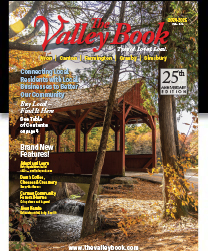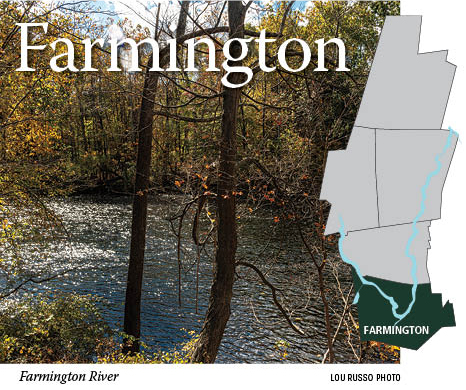Incorporated in 1645, Farmington not only has a very rich history but a unique one. George Washington, who travelled through the town several times during the Revolutionary War, is said to have referred to it as the village of pretty houses — and even now, having grown and changed substantially, Farmington’s charm lives on in perfect balance with its new prosperity. Home to UConn Health Center, world headquarters for both Otis Elevator and the Carrier Corporation, an established industrial park, considerable new development — and with excellent proximity to Westfarms Mall and the major interstates, Farmington is thriving. But at its heart is the historically significant village center that gives this wonderful place its extraordinary appeal, making it one of those twice-blessed towns that has somehow managed to mature without losing its character as a genuine New England village. The town’s most developed area is east of the village, adjacent to Interstate 84, where the University of Connecticut Health Center has continued to grow steadily over the past several years and is now one of the town’s largest employers. Consisting of the University’s medical and dental schools, a teaching hospital, a regional medical reference library, and the Valley’s only emergency room, UConn Health Center provides local residents with access to more than 200 physicians in 50 specialties. It has also stimulated significant nearby development, including multiple office buildings and the clusters of condos, single-family subdivisions, and new schools that have been built in “East Farms.” And a couple of years ago the Health Center campus welcomed Jackson Laboratory, a state-of-the-art facility for the study of the human genome, related diseases, and development of new treatment methodologies. The state invested nearly $300 million in the Jackson Laboratory facility, and the result has been hundreds of new jobs, student internship opportunities, and leading-edge research to the state. Nearby, retail and commercial development flourish at Westfarms Mall, where 160 shops — including national names such as Nordstrom, Macy’s, Lord & Taylor, and J.C. Penney, as well as designer shops, a host of busy specialty stores, and food outlets and eateries — draw shoppers and diners from both sides of the river. But heading west along Route 4 toward Farmington village, the scenery changes. A right onto Mountain Road reveals the Hill-Stead Museum, gracefully set on 152 acres — its 19 elegant rooms the ideal gallery for a nationally recognized collection of Impressionist paintings by such celebrated artists as Manet, Monet, Whistler, Degas, and Cassatt. In the summer, Hill-Stead hosts its annual Sunken Garden Poetry Festival, which draws some of the nation’s most famous poets, along with local talent and a highly appreciative audience. And nearby is the Stanley-Whitman House. Built circa 1720, this classic Colonial was painstakingly restored to depict life as it was in the 18th-century. Prominently located at the heart of the village is the venerable Country Club of Farmington, elegant as ever. And across the street is Vivid Hue Home — a uniquely delightful shop. Stretching more than a mile along Farmington’s Main Street, which runs north/south, is a charming procession of authentic colonial homesteads offering a superb glimpse into past centuries. Many of these residences are also part of the Connecticut Freedom Trail, having been home to early Farmington families who, as committed abolitionists, made their dwellings an important part of the Underground Railroad. In fact, in 1841, 38 Mende Africans — and Cinque, the leader of the famous Amistad slave revolt — lived and studied in Farmington while funds were raised for their eventual return to Africa. These days, several of these residences have become noteworthy museums. Heading north on Main Street takes you to Avon, while a southward course will lead you past Miss Porter’s School, whose many buildings occupy much of the village center. A significant historic and cultural institution in its own right, the school was founded in 1843 and has long been considered one of the finest girls’ college preparatory schools in the country. Traveling west out of the village proper along Route 4 will take you past Highland Park Market, a community favorite, where the choicest ingredients for almost any gourmet meal are routinely in abundance, as is the kind of customer service that’s hard to find elsewhere. Take a left on Town Farm Road a bit further down and you’ll arrive at the Tunxis Country Club, a 45-hole golf course where serious players tee off, the non-serious take in a round of mini golf, hackers dispatch a bucket or two at the driving range — and everybody grabs ice cream at the shop next door. But continue west on Route 4, and you’ll pass by the recently completed and very striking Mormon Temple, which serves members from Connecticut and southwestern Massachusetts and as far away as Rhode Island and Eastern New York. Along the way you’ll spot a wide diversity of dining options popular with weary commuters and connoisseurs alike, from Naples Pizza, Farmington Pizza & Kitchen, and Mama Khang Asian Kitchen to Claudia’s Grinder Shop and Piccolo Arancio. Continue under the “Big Bird” bridge to the Farmington Canal bike trail, which — if you have a bike handy — will take you where the quiet of the town’s meadows yield to Tunxis Mead Park, a maze of well-groomed recreational fields, riverside boat landings, and bustling neighborhoods. Up ahead, you’ll pass a series of more recent housing subdivisions and commercial developments, along with Farmington High School, with its consistently top-ranked academic and athletic programs. Also located here are the town offices and the Farmington Public Library, impressive for its large variety of public programs. And just down the road is the very popular Wood-n-Tap Bar & Grill. As Route 4 continues even further west, you’ll find yourself in a little borough of Farmington called Unionville, where intricately detailed, colorfully painted Victorian-era homes line the main and side streets. Its center comprises Sanford and Hawley Lumber Company (aka “the red store on the corner”), a few small manufacturers, and the old train depot — all reminders of the village’s industrial past. But you’ll also find some great restaurants, too, including Yume Hibachi & Sushi and George’s Pizza. Just past the center is the Unionville Museum. And as Route 4 approaches Burlington, you reach Route 177, which takes you through Farmington’s West District, a section of town where new subdivisions can be seen all the way to the Plainville border — and where Tunxis Community College educates a large number of students from the Valley on their beautifully renovated campus. Imagine. All of that going on just a stone’s throw in any direction from a village center so historic and quaint that the State awarded it the distinction of being named a Connecticut Scenic Route. But then, as noted, Farmington is a town twice blessed — a town that moves forward with ease while looking back with pride. |












































